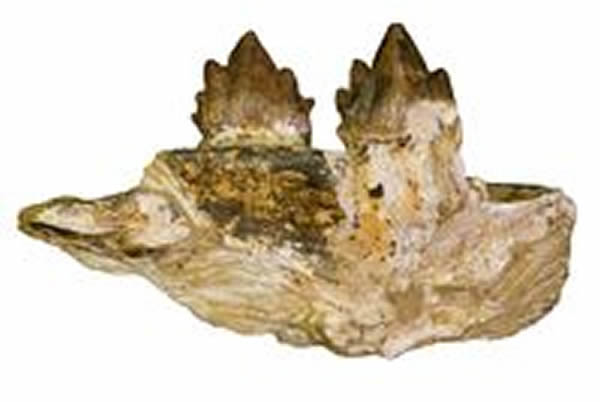New Ancient Members of Whale Family Found
Four new species of ancient whales were related to modern baleen whales, such as this humpback.
Teeth (upper left side of jaw) from Morawanocetus.
The ancestors of modern baleen whales—including the ancient forbears of blue whales (Balaenoptera musculus) and humpbacks (Megaptera novaeangliae)—just got four new relatives.
Scientists announced Sunday that they have discovered the new species thanks in large part to a construction crew in southern California.
The researchers discovered 11 whale species at the site, said Meredith Rivin, a paleontologist at California State University in Fullerton, including the four new species.
The newly identified ancient animals belong to the group including baleen whales, named for the frayed blades of fingernail-like material hanging down from the roof of their mouths, which they use to strain seawater for food.
The four new species of ancient baleen whales had teeth—unlike their current relatives—and are not direct ancestors to modern baleen whales, said Rivin. They represent a transitional step and are related to the animals that would eventually give rise to the whales we know today.
During work on a new road through Laguna Canyon near Los Angeles in 2000, construction crews uncovered an outcrop littered with whale fossils around 17 to 19 million years old.
By that time, Rivin said, toothed baleen whales "were supposed to have been extinct for about five million years or so, and we got a huge diversity of them."
Not only were they not extinct, she said, but it appears that the lineage was doing well at the time.
Before these finds, there weren't any examples of toothed baleen whales from around the world during this time period, called the early Miocene, said Rivin.
Paleontologists accompanying the Southern California crew eventually uncovered hundreds of whale bones and over 30 whale skulls over a five-year period.
Three of the new species are relatively small, about the size of modern-day dolphins, said Rivin.
One of the larger species, a 30-foot (nine-meter) whale in the genus Morawanocetus, is similar to another ancient whale species, Llanocetus denticrenatus, which was thought to have gone extinct 35 million years ago.
Rivin discussed the newly discovered species of ancient toothed baleen whales at the annual American Association for the Advancement of Science meeting in Boston.
She plans to publish papers on three of the four toothed baleen whale species later this year.
The fourth one she's still trying to extract fully from the rock, although she's been able to uncover enough to know that this whale is unlike anything she's ever seen before. Its teeth have very long roots that bulge up from the bone. Rivin plans to keep chipping away at the rock surrounding the fossil until she can study the entire specimen.
Jane J. Lee in Boston
National Geographic News
Published February 19, 2013













